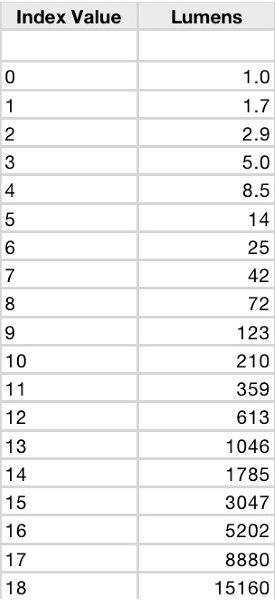JCD
Enlightened
- Joined
- Apr 12, 2010
- Messages
- 892
Knowing the OTF lumens of a flashlight is good data to have. However, when comparing lights, lumens ratings are of limited value. This is because we perceive brightness in a generally logarithmic manner. Doubling the OTF lumens of a flashlight does not double the perceived brightness. I was wondering if anyone else might consider an index value for flashlights based on their relative perceived brightness to be useful.
I put together the following chart based on logarithms of base 1+√(2)/2. (I obtained that base from this post.) Assuming the base number to be correct, then an increase or decrease of less than 1 in the index value would not yield a noticeable difference in brightness (to the naked eye). For example, a 170 lumen flashlight and a 210 lumen flashlight will appear to be approximately the same brightness. However, a 10 lumen flashlight would be noticeably brighter than a 5 lumen flashlight.
Or, put another way, lights with similar index values (a difference of less than one) are approximately equal in perceived brightness, so other factors should be considered more important when choosing between/among them for purchase or use.
I'm interested in feedback, including information regarding the best base number to use for a logarithmic scale.
Note that the following table is a starting point, and not a finished product. It may not be accurate in its present form and might require modification. The goal of starting this thread is to develop a scale that is reasonably accurate in order to compare the perceived brightness of different lights based on their OTF lumens.

To obtain the index value I for a flashlight with x OTF lumens:
I = ln(x) / ln(1+√(2)/2)
I put together the following chart based on logarithms of base 1+√(2)/2. (I obtained that base from this post.) Assuming the base number to be correct, then an increase or decrease of less than 1 in the index value would not yield a noticeable difference in brightness (to the naked eye). For example, a 170 lumen flashlight and a 210 lumen flashlight will appear to be approximately the same brightness. However, a 10 lumen flashlight would be noticeably brighter than a 5 lumen flashlight.
Or, put another way, lights with similar index values (a difference of less than one) are approximately equal in perceived brightness, so other factors should be considered more important when choosing between/among them for purchase or use.
I'm interested in feedback, including information regarding the best base number to use for a logarithmic scale.
Note that the following table is a starting point, and not a finished product. It may not be accurate in its present form and might require modification. The goal of starting this thread is to develop a scale that is reasonably accurate in order to compare the perceived brightness of different lights based on their OTF lumens.

To obtain the index value I for a flashlight with x OTF lumens:
I = ln(x) / ln(1+√(2)/2)
Last edited:

